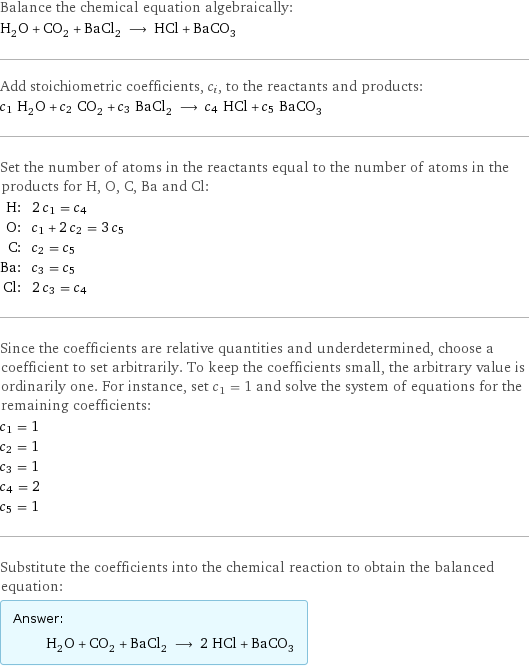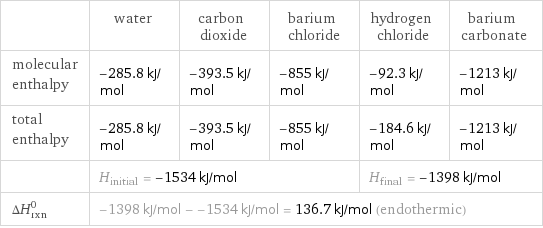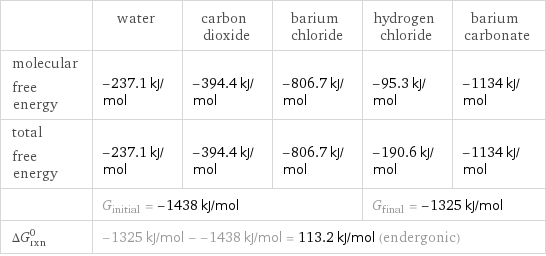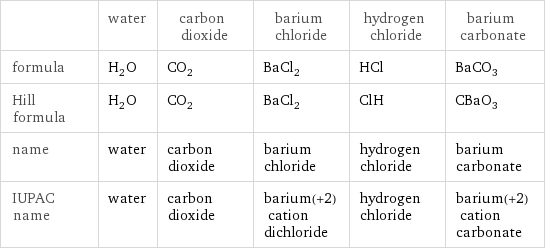Input interpretation

H_2O water + CO_2 carbon dioxide + BaCl_2 barium chloride ⟶ HCl hydrogen chloride + BaCO_3 barium carbonate
Balanced equation

Balance the chemical equation algebraically: H_2O + CO_2 + BaCl_2 ⟶ HCl + BaCO_3 Add stoichiometric coefficients, c_i, to the reactants and products: c_1 H_2O + c_2 CO_2 + c_3 BaCl_2 ⟶ c_4 HCl + c_5 BaCO_3 Set the number of atoms in the reactants equal to the number of atoms in the products for H, O, C, Ba and Cl: H: | 2 c_1 = c_4 O: | c_1 + 2 c_2 = 3 c_5 C: | c_2 = c_5 Ba: | c_3 = c_5 Cl: | 2 c_3 = c_4 Since the coefficients are relative quantities and underdetermined, choose a coefficient to set arbitrarily. To keep the coefficients small, the arbitrary value is ordinarily one. For instance, set c_1 = 1 and solve the system of equations for the remaining coefficients: c_1 = 1 c_2 = 1 c_3 = 1 c_4 = 2 c_5 = 1 Substitute the coefficients into the chemical reaction to obtain the balanced equation: Answer: | | H_2O + CO_2 + BaCl_2 ⟶ 2 HCl + BaCO_3
Structures

+ + ⟶ +
Names

water + carbon dioxide + barium chloride ⟶ hydrogen chloride + barium carbonate
Reaction thermodynamics
Enthalpy

| water | carbon dioxide | barium chloride | hydrogen chloride | barium carbonate molecular enthalpy | -285.8 kJ/mol | -393.5 kJ/mol | -855 kJ/mol | -92.3 kJ/mol | -1213 kJ/mol total enthalpy | -285.8 kJ/mol | -393.5 kJ/mol | -855 kJ/mol | -184.6 kJ/mol | -1213 kJ/mol | H_initial = -1534 kJ/mol | | | H_final = -1398 kJ/mol | ΔH_rxn^0 | -1398 kJ/mol - -1534 kJ/mol = 136.7 kJ/mol (endothermic) | | | |
Gibbs free energy

| water | carbon dioxide | barium chloride | hydrogen chloride | barium carbonate molecular free energy | -237.1 kJ/mol | -394.4 kJ/mol | -806.7 kJ/mol | -95.3 kJ/mol | -1134 kJ/mol total free energy | -237.1 kJ/mol | -394.4 kJ/mol | -806.7 kJ/mol | -190.6 kJ/mol | -1134 kJ/mol | G_initial = -1438 kJ/mol | | | G_final = -1325 kJ/mol | ΔG_rxn^0 | -1325 kJ/mol - -1438 kJ/mol = 113.2 kJ/mol (endergonic) | | | |
Equilibrium constant
![Construct the equilibrium constant, K, expression for: H_2O + CO_2 + BaCl_2 ⟶ HCl + BaCO_3 Plan: • Balance the chemical equation. • Determine the stoichiometric numbers. • Assemble the activity expression for each chemical species. • Use the activity expressions to build the equilibrium constant expression. Write the balanced chemical equation: H_2O + CO_2 + BaCl_2 ⟶ 2 HCl + BaCO_3 Assign stoichiometric numbers, ν_i, using the stoichiometric coefficients, c_i, from the balanced chemical equation in the following manner: ν_i = -c_i for reactants and ν_i = c_i for products: chemical species | c_i | ν_i H_2O | 1 | -1 CO_2 | 1 | -1 BaCl_2 | 1 | -1 HCl | 2 | 2 BaCO_3 | 1 | 1 Assemble the activity expressions accounting for the state of matter and ν_i: chemical species | c_i | ν_i | activity expression H_2O | 1 | -1 | ([H2O])^(-1) CO_2 | 1 | -1 | ([CO2])^(-1) BaCl_2 | 1 | -1 | ([BaCl2])^(-1) HCl | 2 | 2 | ([HCl])^2 BaCO_3 | 1 | 1 | [BaCO3] The equilibrium constant symbol in the concentration basis is: K_c Mulitply the activity expressions to arrive at the K_c expression: Answer: | | K_c = ([H2O])^(-1) ([CO2])^(-1) ([BaCl2])^(-1) ([HCl])^2 [BaCO3] = (([HCl])^2 [BaCO3])/([H2O] [CO2] [BaCl2])](../image_source/17c6f8372b4a01923afdf8e0fda2bc31.png)
Construct the equilibrium constant, K, expression for: H_2O + CO_2 + BaCl_2 ⟶ HCl + BaCO_3 Plan: • Balance the chemical equation. • Determine the stoichiometric numbers. • Assemble the activity expression for each chemical species. • Use the activity expressions to build the equilibrium constant expression. Write the balanced chemical equation: H_2O + CO_2 + BaCl_2 ⟶ 2 HCl + BaCO_3 Assign stoichiometric numbers, ν_i, using the stoichiometric coefficients, c_i, from the balanced chemical equation in the following manner: ν_i = -c_i for reactants and ν_i = c_i for products: chemical species | c_i | ν_i H_2O | 1 | -1 CO_2 | 1 | -1 BaCl_2 | 1 | -1 HCl | 2 | 2 BaCO_3 | 1 | 1 Assemble the activity expressions accounting for the state of matter and ν_i: chemical species | c_i | ν_i | activity expression H_2O | 1 | -1 | ([H2O])^(-1) CO_2 | 1 | -1 | ([CO2])^(-1) BaCl_2 | 1 | -1 | ([BaCl2])^(-1) HCl | 2 | 2 | ([HCl])^2 BaCO_3 | 1 | 1 | [BaCO3] The equilibrium constant symbol in the concentration basis is: K_c Mulitply the activity expressions to arrive at the K_c expression: Answer: | | K_c = ([H2O])^(-1) ([CO2])^(-1) ([BaCl2])^(-1) ([HCl])^2 [BaCO3] = (([HCl])^2 [BaCO3])/([H2O] [CO2] [BaCl2])
Rate of reaction
![Construct the rate of reaction expression for: H_2O + CO_2 + BaCl_2 ⟶ HCl + BaCO_3 Plan: • Balance the chemical equation. • Determine the stoichiometric numbers. • Assemble the rate term for each chemical species. • Write the rate of reaction expression. Write the balanced chemical equation: H_2O + CO_2 + BaCl_2 ⟶ 2 HCl + BaCO_3 Assign stoichiometric numbers, ν_i, using the stoichiometric coefficients, c_i, from the balanced chemical equation in the following manner: ν_i = -c_i for reactants and ν_i = c_i for products: chemical species | c_i | ν_i H_2O | 1 | -1 CO_2 | 1 | -1 BaCl_2 | 1 | -1 HCl | 2 | 2 BaCO_3 | 1 | 1 The rate term for each chemical species, B_i, is 1/ν_i(Δ[B_i])/(Δt) where [B_i] is the amount concentration and t is time: chemical species | c_i | ν_i | rate term H_2O | 1 | -1 | -(Δ[H2O])/(Δt) CO_2 | 1 | -1 | -(Δ[CO2])/(Δt) BaCl_2 | 1 | -1 | -(Δ[BaCl2])/(Δt) HCl | 2 | 2 | 1/2 (Δ[HCl])/(Δt) BaCO_3 | 1 | 1 | (Δ[BaCO3])/(Δt) (for infinitesimal rate of change, replace Δ with d) Set the rate terms equal to each other to arrive at the rate expression: Answer: | | rate = -(Δ[H2O])/(Δt) = -(Δ[CO2])/(Δt) = -(Δ[BaCl2])/(Δt) = 1/2 (Δ[HCl])/(Δt) = (Δ[BaCO3])/(Δt) (assuming constant volume and no accumulation of intermediates or side products)](../image_source/60f63bb62a46f2dfd4a2631d1c789e61.png)
Construct the rate of reaction expression for: H_2O + CO_2 + BaCl_2 ⟶ HCl + BaCO_3 Plan: • Balance the chemical equation. • Determine the stoichiometric numbers. • Assemble the rate term for each chemical species. • Write the rate of reaction expression. Write the balanced chemical equation: H_2O + CO_2 + BaCl_2 ⟶ 2 HCl + BaCO_3 Assign stoichiometric numbers, ν_i, using the stoichiometric coefficients, c_i, from the balanced chemical equation in the following manner: ν_i = -c_i for reactants and ν_i = c_i for products: chemical species | c_i | ν_i H_2O | 1 | -1 CO_2 | 1 | -1 BaCl_2 | 1 | -1 HCl | 2 | 2 BaCO_3 | 1 | 1 The rate term for each chemical species, B_i, is 1/ν_i(Δ[B_i])/(Δt) where [B_i] is the amount concentration and t is time: chemical species | c_i | ν_i | rate term H_2O | 1 | -1 | -(Δ[H2O])/(Δt) CO_2 | 1 | -1 | -(Δ[CO2])/(Δt) BaCl_2 | 1 | -1 | -(Δ[BaCl2])/(Δt) HCl | 2 | 2 | 1/2 (Δ[HCl])/(Δt) BaCO_3 | 1 | 1 | (Δ[BaCO3])/(Δt) (for infinitesimal rate of change, replace Δ with d) Set the rate terms equal to each other to arrive at the rate expression: Answer: | | rate = -(Δ[H2O])/(Δt) = -(Δ[CO2])/(Δt) = -(Δ[BaCl2])/(Δt) = 1/2 (Δ[HCl])/(Δt) = (Δ[BaCO3])/(Δt) (assuming constant volume and no accumulation of intermediates or side products)
Chemical names and formulas

| water | carbon dioxide | barium chloride | hydrogen chloride | barium carbonate formula | H_2O | CO_2 | BaCl_2 | HCl | BaCO_3 Hill formula | H_2O | CO_2 | BaCl_2 | ClH | CBaO_3 name | water | carbon dioxide | barium chloride | hydrogen chloride | barium carbonate IUPAC name | water | carbon dioxide | barium(+2) cation dichloride | hydrogen chloride | barium(+2) cation carbonate